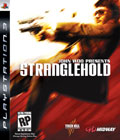Genre: Third-Person Shooter
Publisher: Midway
Developer: Midway
Release Date: October 29, 2007
A pet format of mine, crossing multiple genres, is the often awkward adaptation of film to game, or the almost entirely inadvisable reverse process. Stranglehold is an effort at the former type of transfer, and not even directly so: Stranglehold was never a film but fully represents the now popular, quite slickly produced Hong Kong action movies from notable genre directors like John Woo — particularly his latter-day classic, "Hard Boiled," which shares its protagonist, Tequila Yuen, with the game. Woo also takes directing credit for Stranglehold.
If you're pressed to pick a film genre for game adaptation, you can't do much better than a heavily stylized Hong Kong action film. Indeed there are a slew of enjoyable movies of the type, and a fair number of fine "Hong Kong action films" that have nothing whatsoever to do in their plots with Hong Kong, or even Asia in general. Other Western films have adopted elements of Hong Kong action where appropriate. Like the recent influence, though waning, of Japanese horror films on Hollywood horror films, Hong Kong action films and Woo have made a permanent mark upon many action films produced worldwide. They're especially good fodder for games, certainly for shooters in some perspective or another; other quality film production houses, say, Merchant Ivory, offer nothing for action gaming, really nothing translatable to games of any genre.
After early exposure to a demo version of Stranglehold, I was immediately captivated. After seeing several games adapted from Woo-inspired films stumble and fall flat, I had been skeptical any developer could pull off a Hong Kong action movie in a game, Woo or no Woo at the directing helm. The demo seemed to prove me wrong. While the Xbox 360 game hit shelves on the date more or less expected, the PlayStation 3 version of Stranglehold was delayed more than once, yet even in the face of the many top-tier PS3 titles that rolled out the door, I lost none of my anticipation for this particular game.
The pure action experience of Stranglehold exists within the shell of a plot loosely serial to "Hard Boiled"; principally, it's all about unconventional, perhaps rogue, Hong Kong cop Tequila. He takes down various criminal empires, in the process destroying whole urban neighborhoods, even entire remote villages, while his straight-laced detective captain futilely attempts to keep his agent under thumb. It's a clichéd film and crime novel theme, already so to a great degree before Woo became such a phenomenon; yet Woo can take full credit for setting his films in the trite but keeping his audience from noticing so much.
Likewise, the well-traveled plot path is only irksome if the player chooses to sit back and pick at it. The story is told entirely through cut scenes, longer scenes between missions, briefer pieces within missions serving mostly as introduction for new mission objectives. The voice acting and general filmic feel of the cut scenes is acceptable, but they have nothing on similar scenes in recent PS3 titles like Heavenly Sword. Stranglehold is unabashedly consumed with its action components and suffers very little for lack of a highly motivating plot: Creating total carnage and complete destruction with assault rifles, dual-wielded pistols and shotguns is motivation enough.
The audio production in the game is very good; the full Woo experience is here and the title makes appropriate, if not excessive, use of available multichannel sound. Indeed, listening to the game or listening to a Hong Kong action film of high production value, I'd be hard pressed to tell the difference.
Likewise, in graphics, Stranglehold exploits the near-ubiquitous current version of the Unreal Engine to great effect. Havok physics shine in the title as well, creating, if not realistic effects — remember, we're not after realism here — certainly fascinating physical gymnastics. Almost certainly in avoidance of annoying camera problems present in many otherwise excellent third-person, over-the-shoulder perspective shooters, the developers chose at times to make close or view-obscuring objects wholly or partially transparent. It works but leads to some disconcerting incidents. For example, in an early level, depending on where you position Tequila, a drainpipe running up a wall completely vanishes. Move Tequila somewhere else, and the pipe re-materializes, like magic. However, objects that sometimes up and go missing are never objects with which you must interact to proceed. I much prefer some spectral drainpipes and phantom walls to the frustration of a view blocked by the in-game equivalent of bric-a-brac, all while lethal gunfire rains down on my head.
Stranglehold possesses some truly show-off graphical scenes, as well. For example, using "Precision Aim," a special skill acquired early in the game, you can easily target distant enemies, firing deadly accurate single rounds. While the ensuing "bullet cam" scenes are not interactive, the animations are hardly canned: Your enemies react appropriately to the places they're hit, whether that be groin, hand, knee, neck or smack in the face. It's gory and, well, graphic, but it is indeed fun to watch, a significant accomplishment for a game scene in which all you can do is watch.
Stranglehold's control does what a good control scheme should: It doesn't get in the way. Controller operation is smooth and responsive, and a little way into the game, you've easily memorized which buttons and analog sticks manage what. The game makes liberal use of "Tequila Time," slow-motion interactive gun combat sequences that have appeared in innumerable games over the past several years. Woo, while he shouldn't claim total credit for inventing slow-motion combat sequences in film, certainly uplifted the technique to a signature element of action movies. Unfortunately, the man himself was last to the party in video games. "Tequila Time" is, however, an exceptionally good implementation of the now-familiar hook. It's used a lot, and even though you can manually control the feature, much of it is automatically triggered by how or where you move, or what particular action — shooting, it's always shooting — you're taking.
The title employs what is essentially a combination of pick-up kit and self-regenerating health. Placed throughout mission levels are clearly marked health packs restoring some or all of Tequila's constitution. Additionally, pulling off stylish action sequences — bluntly stated, this means killing a lot of people with flair — "charges" the game's "Tequila Bomb Gauge," a mechanism that lets you use the "charge" to do several unique things, first and foremost tapping a d-pad button to boost Tequila's health in dire circumstances. Other special features of the "Tequila Bomb Gauge" that you'll activate as you progress in the game are, in order of appearance, the aforementioned "Precision Aim," "Barrage Attack" and finally "Spin Attack"; all are aptly named: If you've ever seen half an hour of a Woo film, you can surely imagine what will happen with each. Like the health boosters, all use gauge charge, and you'll have to get fancy all over again with your killing sprees to rapidly recharge the gauge.
Stranglehold does have an online multiplayer component. While it wouldn't be fair to call it a mere afterthought, it just doesn't work well. Hearing the game described, watching gameplay video or even playing the game's demo, the idea of applying this unbridled chaos to a limited number of players in a multiplayer environment seems like wild fun. It's not. Perhaps this is unexpected: After all, gun-toting total mayhem is typically the key element of riotous online battles, but as described, it's truly unbridled chaos — there is no designed control of multiplayer matches, making for a fumbling, confusing mess of obstacle avoidance amidst gunfire as thick as bees in the core of a massive hive.
Graphically excellent, filled with raw action and superior, innovative animation, where Stranglehold falls apart is in length and level design. The film "Hard Boiled" runs about 126 minutes, depending on the cut — rather long for a pure action film, yet Woo carries it. Stranglehold, depending on your skill, luck and the difficulty option you choose — a casual, normal and more difficult setting are all available — the game goes on, drags on, between 10 and 20 hours. To his great credit, Woo can carry his films for a full two hours with those engaging action sequences. A game of the same sort could run maybe four hours, even five hours before bogging down, but the action, however nicely executed, can't carry Stranglehold more than about a third the length most players will take to complete the title. Better level design would have helped. A lot.
Although the mission environments are often excellent, the mission goals are all lackluster, if not outright torpid: You'll find them about as interesting as ticking off items on a grocery list. Finding your way around, though not likely to stall you out for long periods, can also frustrate. According to the game mechanics, items with which you can interact should glow or otherwise feature highlighting. Some do, and some don't. Shoot everything — and of course everyone — and ask questions later; that's the best policy here. Speaking of shooting, a variety of projectile weapons are scattered about for easy pickings, but use of one over the other doesn't make much difference, save cutting short a few boss battles.
Gamers completely enamored of John Woo films must own Stranglehold; that's a given. There's even a reasonably priced collector's edition featuring the entire "Hard Boiled" film, making sharp use of the enhanced storage space of Blu-ray technology. Others should approach with caution: Stranglehold is the poster child for the creation of a new category of very short, lower-priced games that hold together over their abbreviated length.
Score: 7.5/10
More articles about Stranglehold











 Stranglehold is an intense game which will bring John Woo's famous use of hyperkinetic, choreographed action and freeze framed sequences to the video game arena and will also feature the likeness and voice talent of international action film star, Chow Yun-Fat, (Crouching Tiger, Hidden Dragon, Hard Boiled, Bulletproof Monk) in his video game debut.
Stranglehold is an intense game which will bring John Woo's famous use of hyperkinetic, choreographed action and freeze framed sequences to the video game arena and will also feature the likeness and voice talent of international action film star, Chow Yun-Fat, (Crouching Tiger, Hidden Dragon, Hard Boiled, Bulletproof Monk) in his video game debut.






















